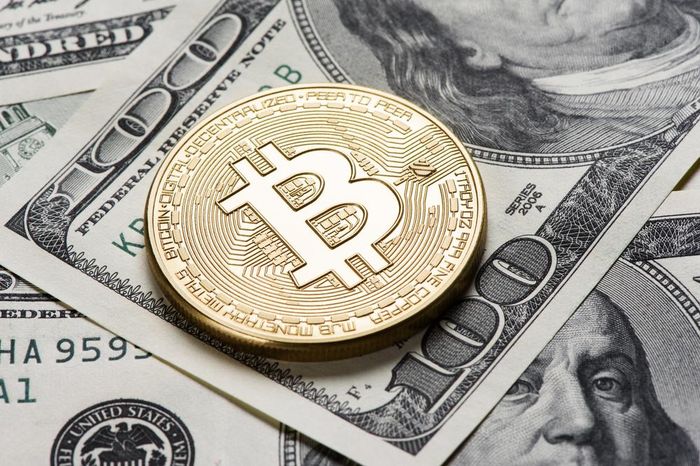Bitcoin and Wall Street under pressure as geopolitical risks increase

Last week, bitcoin and US stocks came under downward pressure due to rising bond yields and geopolitical risks.
The world's largest digital currency hovered around $70,000/BTC for most of the week, but had a volatile weekend session, falling below $62,000/BTC on April 13 before returned to 65,000 USD/BTC on the morning of April 14.
Meanwhile, the S&P 500 index ended the last trading week at 5,123.41 points, down 1.56%; The Nasdaq Composite technology index closed at 16,173.09, down 0.5%; The Dow Jones index closed at 37,983.37 points, down 2.4%.
Traders and investors sold bitcoin and stocks following mixed reports regarding inflation last week. They note the possibility that the US Federal Reserve (Fed) will delay cutting interest rates in 2024 or completely abandon this plan.
The prospect of delaying or abandoning interest rate cuts also doesn't help the bond market.
The 10-year US government bond ended last week with a yield of 4.49%, up from 4.40% at the beginning of the week, after hitting 4.60% mid-week.
Bond yields are rising as bitcoin is trading near an all-time high. These conditions make both bitcoin and stocks vulnerable to sell-offs, as investors tend to sell risky assets in favor of less risky assets.
Mr. Ronen Cojocaru, CEO of financial services company 8081, said: 'As inflationary pressures increase, central banks may tighten monetary policy, causing prices of many asset classes to increase. various, including cryptocurrencies, dropped.'
Meanwhile, bond yields have not increased enough to normalize the yield curve. The 10-year bond yield trades 0.4 percentage point below the 2-year yield and 0.95 percentage point below the 3-month yield.
Long-term bond yields are lower than short-term bond yields, which Wall Street experts call an inverted yield curve, leaving the banking sector vulnerable to a sell-off.
An inverted yield curve is bad news for traditional banks. It hurts bank earnings as banks compete for funds with money market mutual funds and exchange-traded funds (ETFs) issued by financial companies.
That is clearly shown in the first quarter 2024 financial results of major banks announced last weekend, which was the cause of the sell-off of banking stocks on April 12.
Additionally, escalating geopolitical risks add to uncertainty on Wall Street, putting further pressure on the stock market.
One of these risks is the increasingly fierce dispute between the US and China in the technology industry, as both sides increase sanctions against each other.
The geopolitical crisis in the Middle East, which peaked over the weekend after Iran attacked Israel with drones and missiles, also added pressure to the market.
This move could spread instability in the region, causing unpredictable consequences for world peace and financial markets.
Despite tensions between countries, experts believe the likelihood of a large-scale conflict is very low as it could be disastrous for all involved.
Therefore, long-term investors should focus on the most important factor driving stock prices: growth in the business's revenue and profits. In the coming weeks, companies will report their first quarter 2024 results. This will be a good indicator of their financial situation./.
You should read it
- What do you need to know when buying Bitcoin or selling Bitcoin?
- Guide to digging Bitcoin for beginners
- Today's Bitcoin price, Bitcoin price update every minute
- The world only has 20% Bitcoin to 'dig'
- 10 facts about Bitcoin
- Crossing virtual walls, Bitcoin exploded in real life
- How to interpret bitcoin that your grandparents can understand
- What is Satoshi? 1 Satoshi is how many Bitcoin?
May be interested
- How to dig bitcoin without wasting electricity
 with the value of bitcoin peaking this week, people also discovered that digging virtual money consumes more electricity than the needs of 159 different countries in the world.
with the value of bitcoin peaking this week, people also discovered that digging virtual money consumes more electricity than the needs of 159 different countries in the world. - Watch your eyes on the talented graffiti artist turn ugly, tedious walls into stunning 3D works
 with meticulous attention to detail about light and darkness, vile created 'transparent' walls that made it difficult for viewers to recognize them as just a flat wall.
with meticulous attention to detail about light and darkness, vile created 'transparent' walls that made it difficult for viewers to recognize them as just a flat wall. - What is a pressure cooker? Structure, uses and usage of pressure cooker safety you need to know
 in essence, what are pressure cookers, how do they use them and are they constructed? stay tuned for the sharing below to better understand this product line!
in essence, what are pressure cookers, how do they use them and are they constructed? stay tuned for the sharing below to better understand this product line! - What is a pressure cooker? Which model pressure cooker should you buy best?
 mechanical pressure cookers will help you to stew bones, beef tendons or cook porridge, black beans quickly without losing time. take a quick look at the following article to choose the best mechanical pressure cooker.
mechanical pressure cookers will help you to stew bones, beef tendons or cook porridge, black beans quickly without losing time. take a quick look at the following article to choose the best mechanical pressure cooker. - What is Bitcoin faucet? What is Bitcoin faucet?
 what is bitcoin faucet or bitcoin faucet? bitcoin faucet is bitcoin faucet, reward system, in the form of website, application. these bitcoin tubes will distribute rewards in satoshi format, a bitcoin currency, for visitors who have completed captcha or tasks requested by the website.
what is bitcoin faucet or bitcoin faucet? bitcoin faucet is bitcoin faucet, reward system, in the form of website, application. these bitcoin tubes will distribute rewards in satoshi format, a bitcoin currency, for visitors who have completed captcha or tasks requested by the website. - What do you need to know when buying Bitcoin or selling Bitcoin?
 digging bitcoin is not the only way to get bitcoin. in fact, bitcoin mining is not an easy job, at least, you need dedicated software, a hardware device to run it and a significant amount of power to power it. in fact, the easiest way to accumulate bitcoin is to buy it.
digging bitcoin is not the only way to get bitcoin. in fact, bitcoin mining is not an easy job, at least, you need dedicated software, a hardware device to run it and a significant amount of power to power it. in fact, the easiest way to accumulate bitcoin is to buy it. - Good and unique jokes for the newspaper on November 20
 contributing to the attraction as well as the laughter for the wall newspaper, the jokes are the most suitable option when you make a newspaper.
contributing to the attraction as well as the laughter for the wall newspaper, the jokes are the most suitable option when you make a newspaper. - Too much vitamin C causes insomnia and high blood pressure
 overuse of vitamin c also leads to many risks to your health such as causing insomnia and high blood pressure
overuse of vitamin c also leads to many risks to your health such as causing insomnia and high blood pressure - 4 reasons why Bitcoin's price increase will last a long time
 in analysis shared via x, renowned crypto analyst, ted (@tedtalksmacro), provided compelling evidence to support the assertion that the current bitcoin bull run is far from over.
in analysis shared via x, renowned crypto analyst, ted (@tedtalksmacro), provided compelling evidence to support the assertion that the current bitcoin bull run is far from over. - Guide to digging Bitcoin for beginners
 one of the biggest obstacles i encountered when i started digging bitcoin for investment and profit was that most websites were written for experienced users. i am not a professional coder, i have no experience with ubuntu, linux or mac operating systems. so, below, i will show you how to dig the simplest bitcoin.
one of the biggest obstacles i encountered when i started digging bitcoin for investment and profit was that most websites were written for experienced users. i am not a professional coder, i have no experience with ubuntu, linux or mac operating systems. so, below, i will show you how to dig the simplest bitcoin.










 Bitcoin price today April 16: Dropped sharply to 62,450 USD
Bitcoin price today April 16: Dropped sharply to 62,450 USD 50 Bitcoins from the 'Satoshi Era' Move After 14 Years of Inactivity
50 Bitcoins from the 'Satoshi Era' Move After 14 Years of Inactivity US stocks plunged because investors were concerned about Middle East tensions and bond yields climbed
US stocks plunged because investors were concerned about Middle East tensions and bond yields climbed Bitcoin price today April 15: Slight recovery trading around 64,900 USD
Bitcoin price today April 15: Slight recovery trading around 64,900 USD Hong Kong officially approved a series of Bitcoin spot ETFs
Hong Kong officially approved a series of Bitcoin spot ETFs Bitcoin plunged after peaking at nearly 74,000 USD
Bitcoin plunged after peaking at nearly 74,000 USD